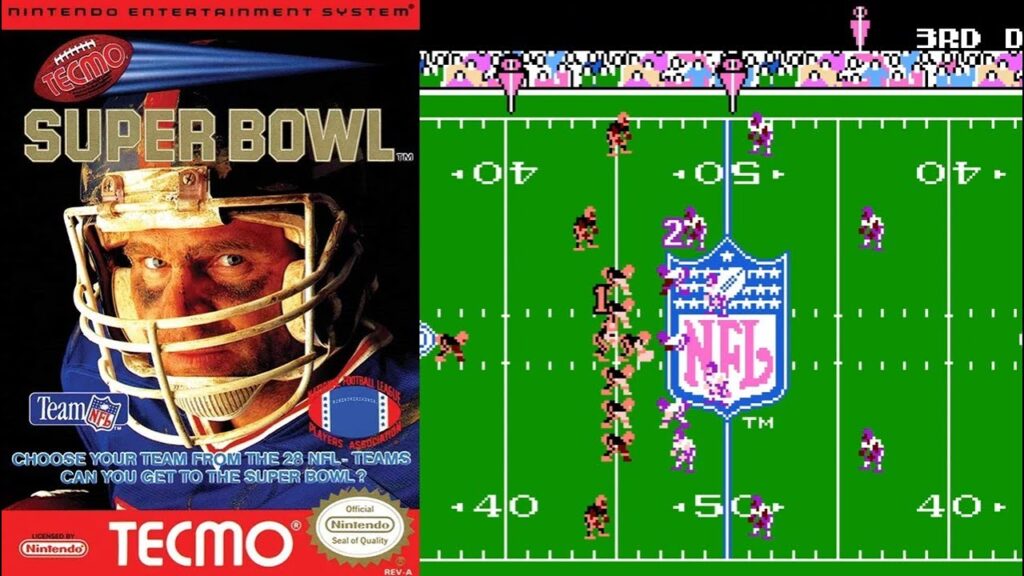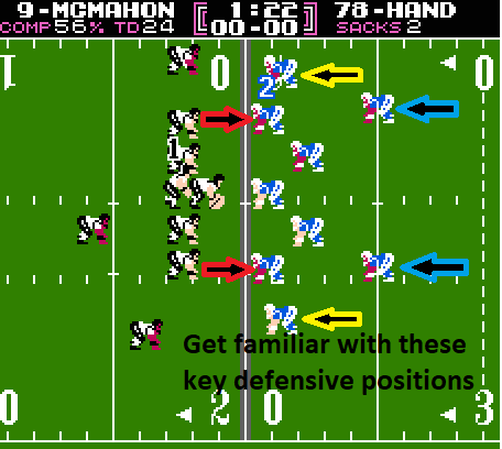

Table of Contents
ToggleIntroduction
Released in February 1989, Tecmo Bowl emerged as a groundbreaking sports game that captured the attention of gamers and sports enthusiasts alike. Developed and published by Tecmo, this classic football game set itself apart from its contemporaries with a blend of fast-paced arcade action and early simulation elements. Before titles like Madden NFL and NFL 2K became household names, Tecmo Bowl was the standard-bearer for digital football experiences on the NES, showcasing Tecmo’s innovative approach to the genre.
The Iconic Roots of Tecmo Bowl

Sports games on the NES were often quick, arcade-like experiences. This simplicity likely contributed to their popularity, as they were easy to pick up and play. While simulation games did not appeal to everyone, Tecmo Bowl was one of the rare titles that transcended biases and captured a wide audience. Before modern franchises like Madden and NFL 2K, Tecmo Bowl set the standard for football games.
The NES version of Tecmo Bowl was a modified port of its arcade predecessor. The arcade game featured only two fictional teams, the Wildcats and Bulldogs, but Tecmo’s Nintendo debut secured an NFL player license, making it one of the first games to include real player names and stats. Despite featuring only twelve teams, this addition gave the game authenticity and helped it achieve landmark status in the sports genre.
Adapting for the NES Platform
![NES Longplay [900] Tecmo Bowl - YouTube Tecmo Bowl](https://i.ytimg.com/vi/_9vp9TkSSWw/hqdefault.jpg)
To fit the NES’s technical constraints, some adjustments were necessary. Instead of the typical eleven players per team, each side only had nine. Additionally, game and season stats were omitted, likely due to the limits of the NES hardware and to support the password save system. This simplified the game while retaining its engaging nature. Matches were also shortened to quarters of just 1:30, which kept the gameplay fast-paced and true to its arcade roots.
Tecmo Bowl balanced realism and playability within the NES’s limitations. On offense, players could choose between four plays split between running and passing. However, the AI’s aggressiveness limited the time available to make strategic choices, often leading to quick sacks if indecision crept in. On defense, selecting the correct counterplay could lead to a successful blitz, but an incorrect guess left players vulnerable to big gains by the opposing team.
Fast-Paced Gameplay and Team Specialties

One of Tecmo Bowl’s standout features was its brisk pace. Plays developed rapidly, with downs often lasting only a few seconds. Passing plays were challenging, as the AI’s defensive prowess limited yardage gains. Running plays similarly demanded skill, as breaking free from defenders was rare due to subtle rubberband mechanics. Despite not using official NFL teams, the player rosters and stats imbued each team with a unique identity. The Giants boasted the best defense, while San Francisco and Chicago excelled at the running game, showcasing strategic variety.
However, quirks in the gameplay became apparent over time. Notably, certain players like Bo Jackson were nearly invincible, bulldozing defenders effortlessly. While this reflected his real-life dominance, it could frustrate those facing him. Similarly, standout running backs like Walter Payton and Barry Sanders could outrun any defender, a trait that the computer utilized to its advantage. These elements, while slightly unbalanced, added to the game’s distinct personality.
Technical Achievements and Sound Design

From a technical perspective, Tecmo Bowl was impressive. Managing 18 players on the field without significant slowdown or sprite flicker was no small feat, particularly when compared to other NES sports titles like 10-Yard Fight. The game’s dynamic cutscenes for halftime shows and touchdowns added visual flair, enhancing the overall presentation.
The soundtrack of Tecmo Bowl stood out for its time, featuring catchy tunes that played during gameplay instead of leaving long silences. The music adapted to game events, highlighting moments like interceptions and touchdowns, and even incorporated voice samples—a notable technical achievement for 1989. This attention to detail contributed to the game’s enduring appeal.
Enduring Legacy

For many, Tecmo Bowl was their first football game experience, and it left an indelible mark. Despite its limitations, it remains a beloved classic with a dedicated fanbase that continues to update its rosters annually. This level of commitment speaks to its quality and the nostalgia it evokes. Revisiting Tecmo Bowl today reveals why it is still recommended as a must-play for fans of retro gaming.
Conclusion
Tecmo Bowl stands as a seminal entry in the history of sports video games, representing a major leap forward in terms of gameplay, strategy, and technical achievements on the NES. Despite its limitations and quirks, such as the simplified plays and occasional unfair AI behaviors, it successfully captures the essence of football with an arcade-style charm that appeals to a wide range of players. The game’s dynamic soundtrack, solid pacing, and innovative player rosters added a layer of realism that was groundbreaking for its time.
Decades later, Tecmo Bowl still holds a special place in the hearts of retro gamers and football enthusiasts alike. Its legacy is cemented by the passionate community that continues to celebrate the game, even updating its rosters yearly to keep the spirit alive. For newcomers and veterans, revisiting Tecmo Bowl is not just a nostalgic journey but a testament to a classic that paved the way for modern football video games.




